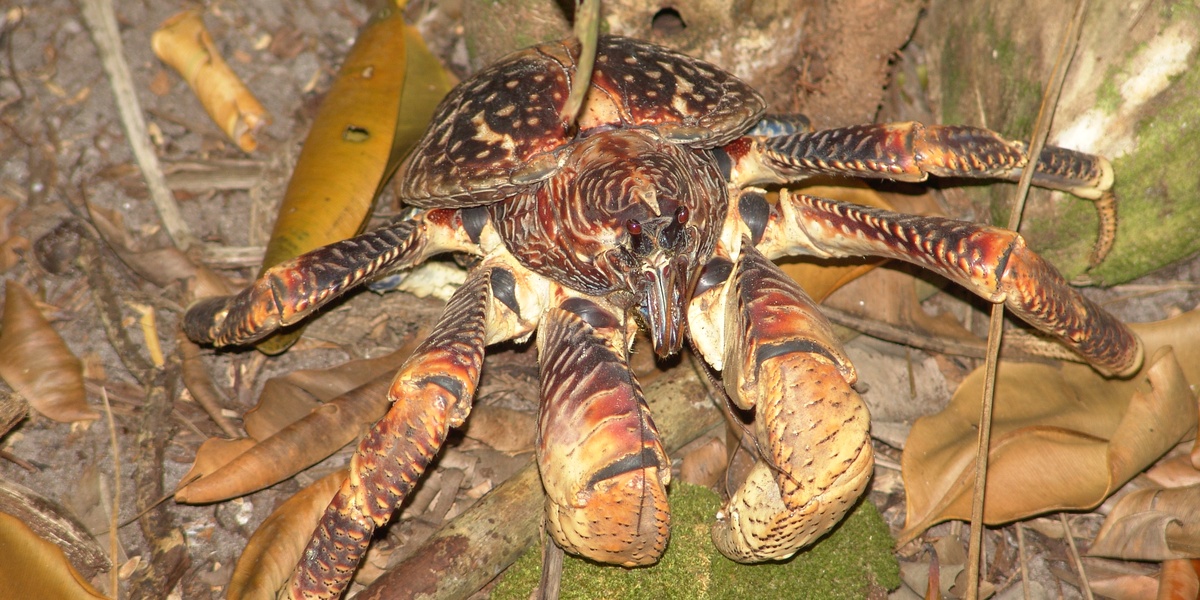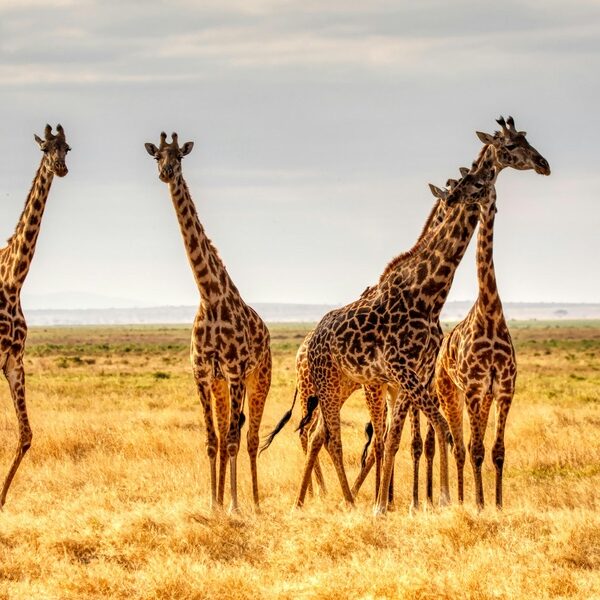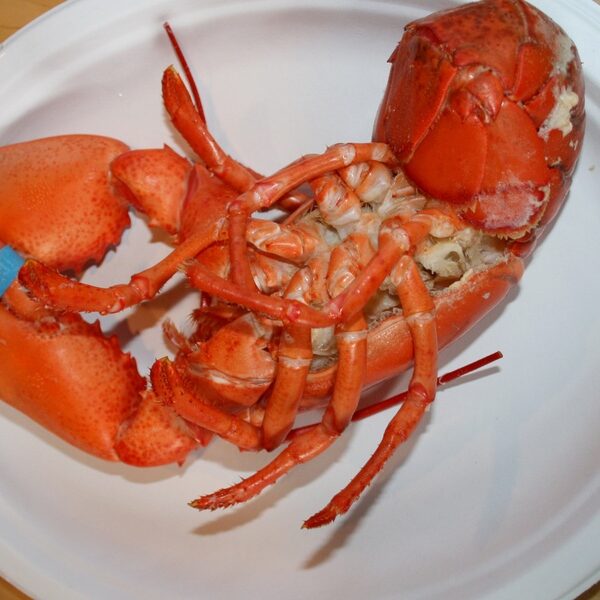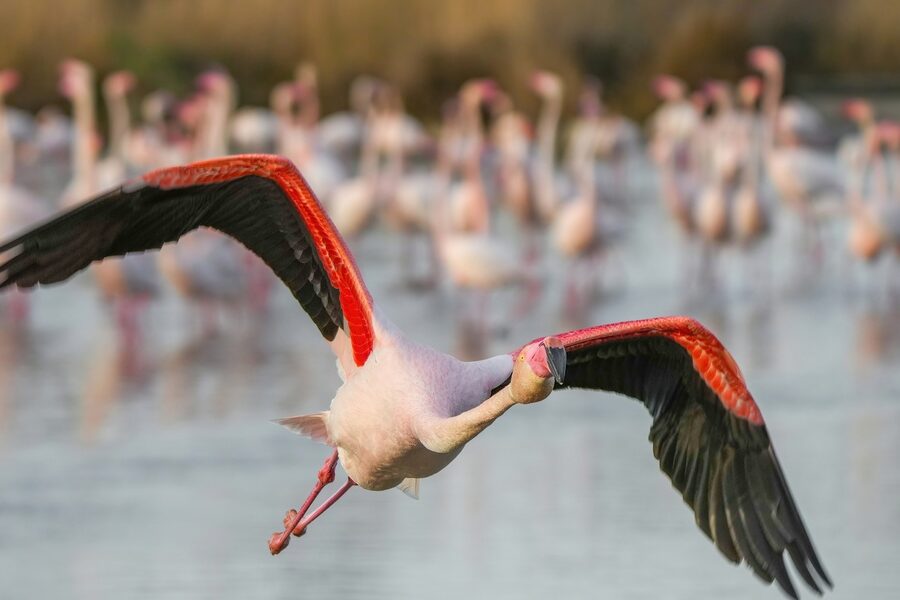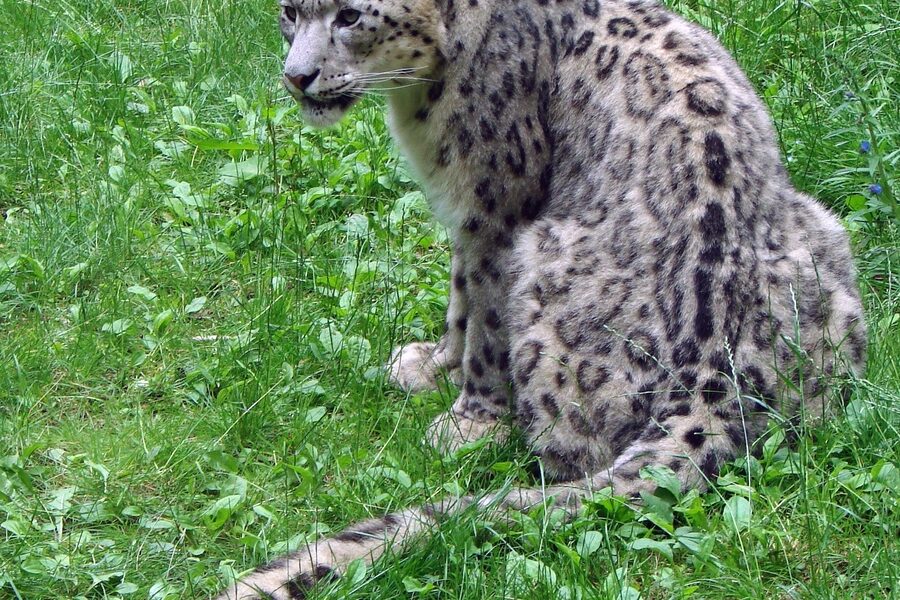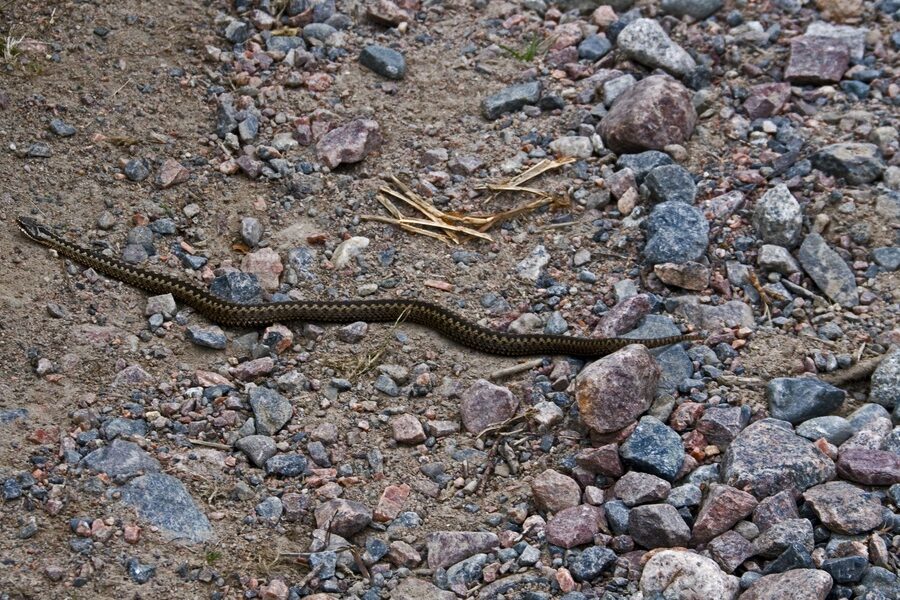Micronesia’s scattered islands and surrounding reefs support a distinctive mix of marine and terrestrial life shaped by isolation and varied habitats. From coral flats to upland forests, species here often have small ranges and specialized roles in local ecosystems.
There are 43 Micronesia’s native animals, ranging from the coral-grazing Bumphead Parrotfish to the island-roosting Yap Flying Fox. For each species we list Scientific name, Conservation (IUCN), Range / islands — you’ll find below.
Which species on this list need the most urgent attention?
Look at the Conservation (IUCN) column to spot Vulnerable, Endangered, or Critically Endangered listings; island endemics, seabirds, and some bats often appear most at risk due to habitat loss, invasive species, and overfishing. Use the status and range together to prioritize actions or further reading, and consult IUCN or local agencies for up-to-date recovery plans.
How can I use the Scientific name, Conservation (IUCN), and Range / islands fields?
Scientific names remove ambiguity when researching species, the Conservation (IUCN) field shows current threat level and context, and Range / islands helps identify where a species occurs—use these columns to plan field visits, report sightings to citizen science projects, or match species to regional conservation measures.
Micronesia’s Native Animals
| Name | Scientific name | Conservation (IUCN) | Range / islands |
|---|---|---|---|
| Mariana Fruit Bat | Pteropus mariannus | Endangered (EN) | Mariana Islands; forests |
| Palau Flying Fox | Pteropus pelewensis | Near Threatened (NT) | Palau; forests |
| Pohnpei Flying Fox | Pteropus pohnpeiensis | Critically Endangered (CR) | Pohnpei; upland forests |
| Yap Flying Fox | Pteropus yapensis | Vulnerable (VU) | Yap; forests and mangroves |
| Dugong | Dugong dugon | Vulnerable (VU) | Palau; sheltered coastal seagrass beds |
| Spinner Dolphin | Stenella longirostris | Least Concern (LC) | Throughout Micronesia; deep offshore waters |
| Micronesian Megapode | Megapodius laperouse | Vulnerable (VU) | Palau, Mariana Islands; forests, coastal scrub |
| Palau Ground Dove | Alopecoenas canifrons | Near Threatened (NT) | Palau (Rock Islands); limestone forests |
| Mariana Fruit Dove | Ptilinopus roseicapilla | Endangered (EN) | Rota, Saipan, Tinian, Aguiguan; forests |
| Kosrae Fruit Dove | Ptilinopus hernsheimi | Near Threatened (NT) | Kosrae; forests |
| Micronesian Imperial Pigeon | Ducula oceanica | Near Threatened (NT) | Palau, Yap, Chuuk, Pohnpei, Kosrae; forests |
| Pohnpei Lorikeet | Trichoglossus rubiginosus | Near Threatened (NT) | Pohnpei; all elevations, forests, plantations |
| Mariana Swiftlet | Aerodramus bartschi | Endangered (EN) | Guam, Saipan, Aguiguan; limestone caves |
| Guam Rail | Gallirallus owstoni | Extinct in the Wild (EW) | Guam (reintroduced on Cocos & Rota) |
| Micronesian Kingfisher | Todiramphus cinnamominus | Critically Endangered (CR) | Pohnpei, Guam (EW), Palau; forests |
| Palau Fantail | Rhipidura lepida | Least Concern (LC) | Palau; various forest types |
| Pohnpei Fantail | Rhipidura kubaryi | Least Concern (LC) | Pohnpei; forests |
| Tinian Monarch | Monarcha takatsukasae | Near Threatened (NT) | Tinian; limestone forests |
| Chuuk Monarch | Metabolus rugensis | Vulnerable (VU) | Chuuk (Tol, Wonei, Pata); forests |
| Micronesian Myzomela | Myzomela rubratra | Least Concern (LC) | Palau, Marianas, Yap, Chuuk, Pohnpei, Kosrae |
| Rota White-eye | Zosterops rotensis | Endangered (EN) | Rota; mature, high-canopy forests |
| Golden White-eye | Cleptornis marchei | Vulnerable (VU) | Saipan, Aguiguan; native limestone forest |
| Giant White-eye | Megazosterops palauensis | Near Threatened (NT) | Palau; forests |
| Micronesian Starling | Aplonis opaca | Least Concern (LC) | Palau, Marianas, Yap, Chuuk, Pohnpei, Kosrae |
| Pohnpei Starling | Aplonis pelzelni | Critically Endangered (CR) | Pohnpei; mountain forests |
| Saltwater Crocodile | Crocodylus porosus | Least Concern (LC) | Palau; mangroves, estuaries, marine lakes |
| Green Sea Turtle | Chelonia mydas | Endangered (EN) | Throughout Micronesia; oceans, nesting on beaches |
| Hawksbill Sea Turtle | Eretmochelys imbricata | Critically Endangered (CR) | Throughout Micronesia; coral reefs, nesting on beaches |
| Mariana Monitor | Varanus tsukamotoi | Not Evaluated (NE) | Mariana Islands; forests, coastal areas |
| Pacific Tree Boa | Candoia bibroni | Not Evaluated (NE) | Palau, Eastern Micronesia; forests |
| Palau Frog | Platymantis pelewensis | Least Concern (LC) | Palau; forest floor |
| Napoleon Wrasse | Cheilinus undulatus | Endangered (EN) | Throughout Micronesia; coral reefs |
| Bumphead Parrotfish | Bolbometopon muricatum | Vulnerable (VU) | Throughout Micronesia; coral reefs |
| Oceanic Manta Ray | Mobula birostris | Endangered (EN) | Throughout Micronesia; offshore waters, cleaning stations |
| Grey Reef Shark | Carcharhinus amblyrhynchos | Endangered (EN) | Throughout Micronesia; coral reefs |
| Golden Jellyfish | Mastigias papua etpisoni | Not Evaluated (NE) | Palau (Jellyfish Lake); marine lake |
| Pohnpei Mangrove Goby | Stiphodon caeruleus | Not Evaluated (NE) | Pohnpei; freshwater streams |
| Palauan Dottyback | Pseudochromis palauensis | Not Evaluated (NE) | Palau; coral reef drop-offs |
| Coconut Crab | Birgus latro | Vulnerable (VU) | Most islands; coastal forests |
| Giant Clam | Tridacna gigas | Vulnerable (VU) | Palau, Yap, Chuuk; shallow coral reefs |
| Palau Nautilus | Nautilus belauensis | Not Evaluated (NE) | Palau; deep reef slopes (150-300m) |
| Mariana Eight-spot Butterfly | Hypolimnas octocula marianensis | Not Evaluated (NE) | Guam, Saipan; forests |
| Pohnpei Tree Snail | Partula emersoni | Critically Endangered (CR) | Pohnpei; native upland forests |
Images and Descriptions
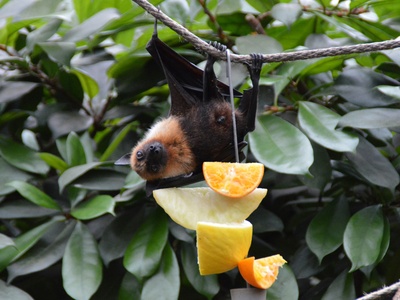
Mariana Fruit Bat
Also known as the fanihi, this large flying fox is a crucial pollinator and seed disperser. It faces threats from habitat loss and historical overhunting, making it a key conservation focus in the Marianas.
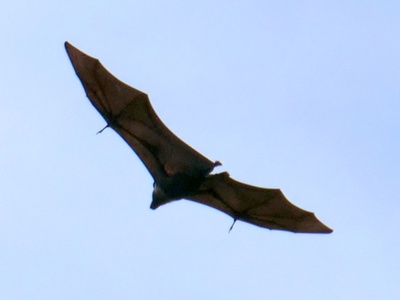
Palau Flying Fox
Slightly smaller than its Mariana relative, this bat is vital to Palau’s forest ecosystems. It is a common sight at dusk, feeding on fruit and nectar, and plays a significant role in local culture.
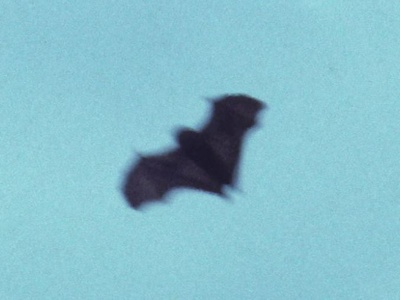
Pohnpei Flying Fox
Endemic to Pohnpei, this large fruit bat is one of the most threatened in the world. Its population has severely declined due to habitat destruction and hunting, making its survival dependent on urgent conservation action.
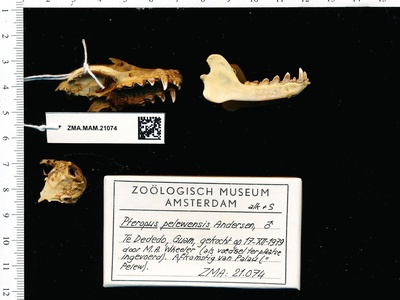
Yap Flying Fox
This flying fox is endemic to the Yap Main Islands. It’s an important pollinator and a cultural symbol, but its population is threatened by typhoons, habitat loss, and hunting pressure for local consumption and trade.
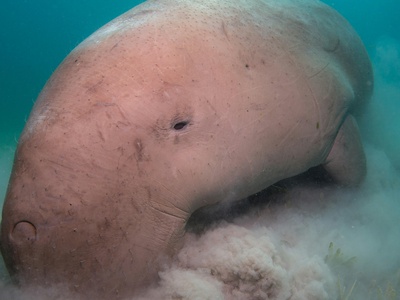
Dugong
Palau is home to the most isolated dugong population in the world. These gentle marine mammals, also known as sea cows, are threatened by boat strikes and degradation of their vital seagrass habitats.
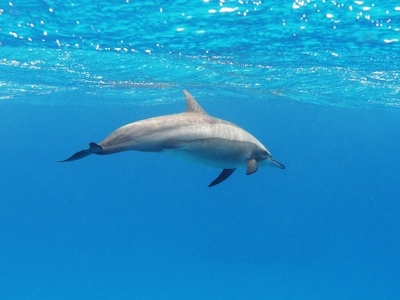
Spinner Dolphin
Famous for their acrobatic leaps and spins, these dolphins travel in large pods. They are a common sight in the deep channels and open ocean surrounding Micronesia’s islands, feeding on fish and squid at night.
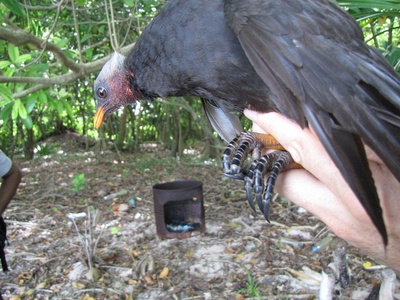
Micronesian Megapode
This unique, chicken-sized bird doesn’t incubate its eggs with body heat. Instead, it buries them in mounds of composting vegetation or geothermally heated soil, letting nature do the work.
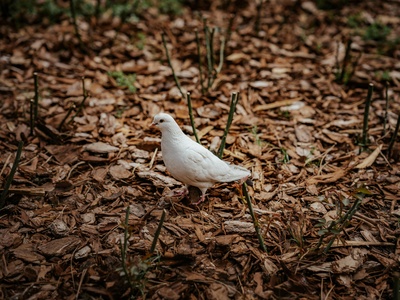
Palau Ground Dove
This shy, ground-dwelling dove is notoriously difficult to spot. It forages for seeds and fallen fruits on the forest floor of Palau’s unique Rock Islands, a UNESCO World Heritage site.
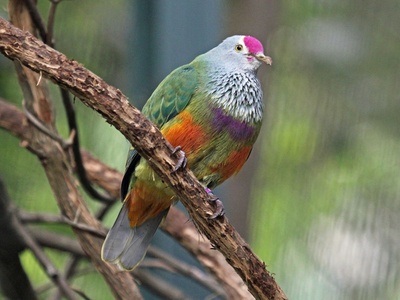
Mariana Fruit Dove
Known locally as the “Totot,” this stunningly colorful dove is the official bird of the Northern Mariana Islands. It has been driven to extinction on Guam by the invasive brown tree snake.
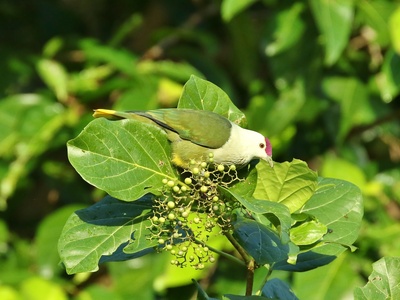
Kosrae Fruit Dove
This small, brightly colored dove is endemic to the island of Kosrae. Its vibrant green body, purple cap, and yellow belly make it a beautiful resident of the island’s lush, mountainous forests.
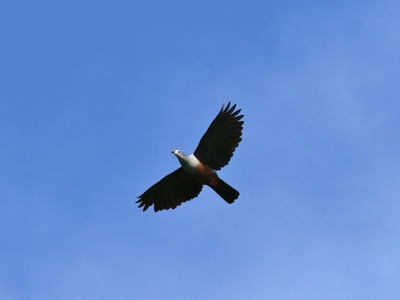
Micronesian Imperial Pigeon
One of the largest native land birds in the region, this pigeon travels between islands to feed on fruit. Its role as a seed disperser for large-fruited trees makes it critical for forest health.
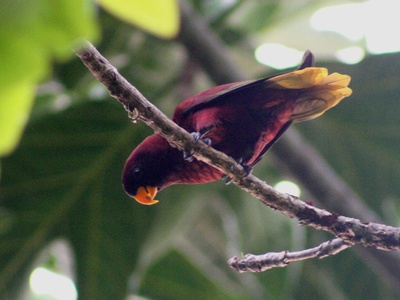
Pohnpei Lorikeet
This small, reddish-maroon parrot is endemic to Pohnpei and is its official bird. It travels in noisy flocks, feeding on nectar and pollen, and is a common, charismatic sight across the island.
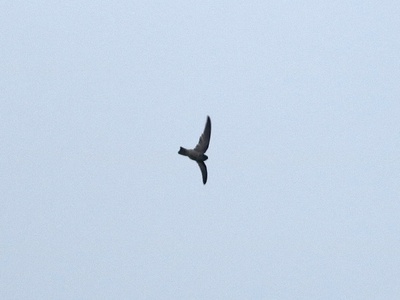
Mariana Swiftlet
This small, fast-flying bird navigates and nests in total darkness using echolocation. Its populations have been decimated by predators and habitat disturbance, making cave protection critical for its survival.
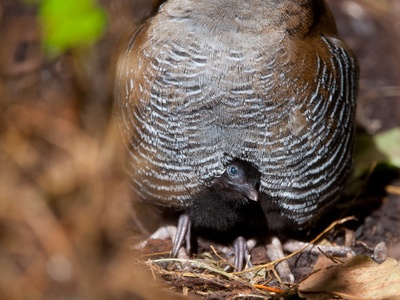
Guam Rail
A flightless bird endemic to Guam, the Ko’ko’ was wiped out in the wild by the brown tree snake. It now exists only through a successful captive breeding and reintroduction program, a symbol of hope.
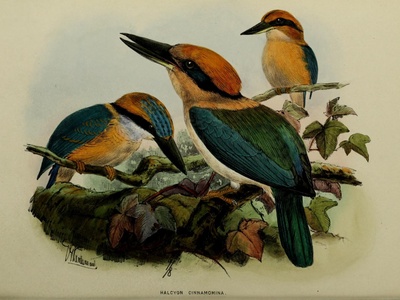
Micronesian Kingfisher
This beautiful kingfisher has distinct subspecies across the islands. The Guam subspecies is extinct in the wild, while the Pohnpei subspecies is highly threatened by habitat loss, highlighting the fragility of island ecosystems.
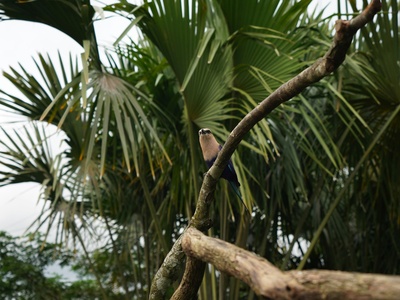
Palau Fantail
A common and active insect-eating bird found only in Palau. It is recognized by its constantly fanned reddish-brown tail and inquisitive nature, often following hikers through the forest understory.
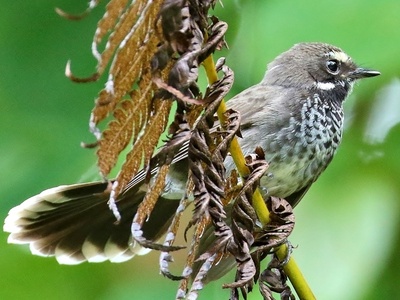
Pohnpei Fantail
Endemic to Pohnpei, this small, energetic bird is named for its habit of fanning its dark tail to flush out insects. It is a common and conspicuous resident of the island’s wet mountain forests.
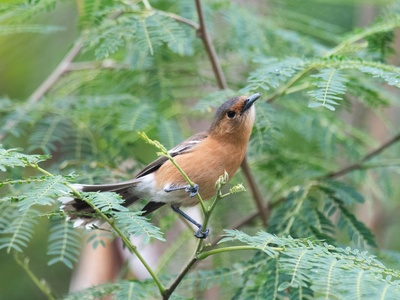
Tinian Monarch
This small flycatcher is found only on the island of Tinian. It has survived habitat destruction from WWII and agricultural development, but its small range makes it perpetually vulnerable to threats like typhoons.
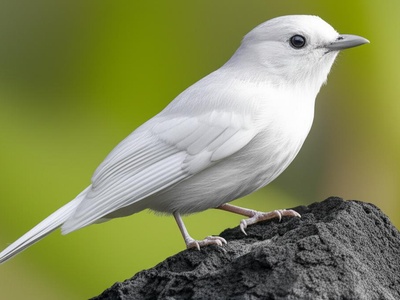
Chuuk Monarch
A striking bird where males are all-white and females are mostly dark. Found only on a few small islands in the Chuuk Lagoon, it is highly vulnerable due to its extremely restricted range.
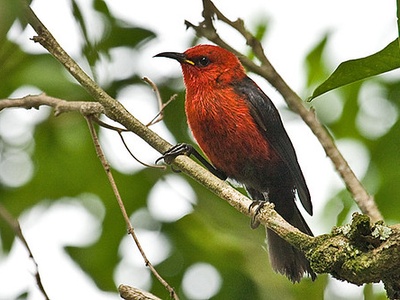
Micronesian Myzomela
This small, brightly colored honeyeater is one of Micronesia’s most common native birds. Males are strikingly black and scarlet, and their cheerful calls are a familiar sound in gardens and forests across the region.
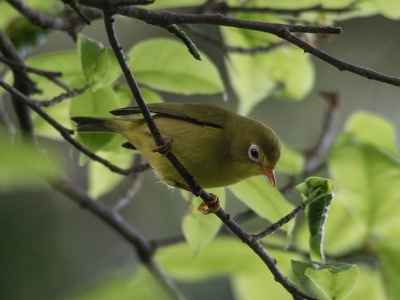
Rota White-eye
Found only on the island of Rota, this small, yellowish bird is threatened by forest clearing for agriculture and development. Its survival depends on the protection of the island’s remaining mature native forests.
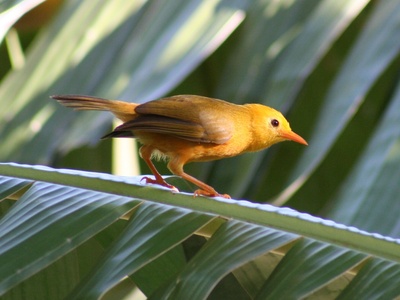
Golden White-eye
This bright, golden-orange bird is unique to Saipan and Aguiguan in the Mariana Islands. Unlike other white-eyes, it lacks the typical white eye-ring. It is threatened by habitat loss and potential predators.
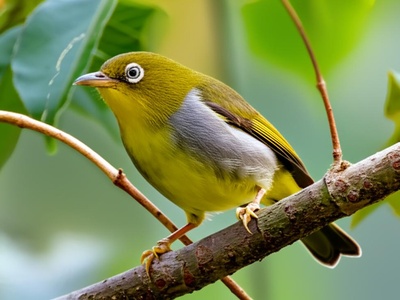
Giant White-eye
Endemic to Palau, this is the largest white-eye species in the world. It is much larger and more robust than its relatives, with a distinct pale eye and a loud, melodic song.
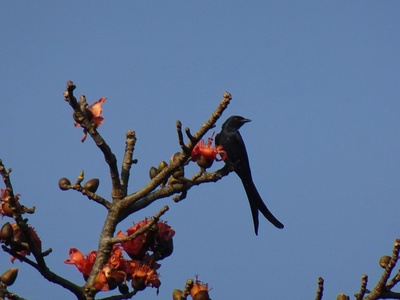
Micronesian Starling
A widespread and adaptable native bird with glossy black plumage and a bright yellow-orange eye. It is an important seed disperser and one of the few native species that has thrived in human-altered habitats.
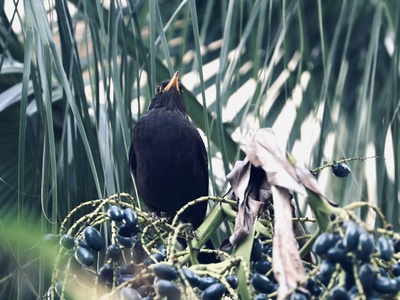
Pohnpei Starling
Endemic to Pohnpei, this starling is so rare it is often feared extinct, though unconfirmed sightings persist. Its drastic decline is likely due to predation by introduced rats and habitat loss.
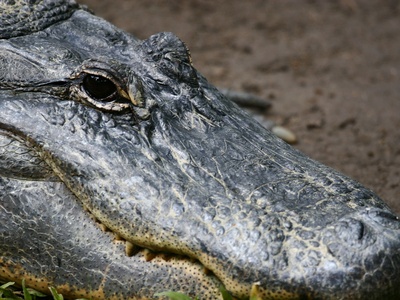
Saltwater Crocodile
Palau is the only part of Micronesia with a native crocodile population. These massive reptiles are apex predators in the mangrove ecosystems and are both respected and feared in Palauan culture.
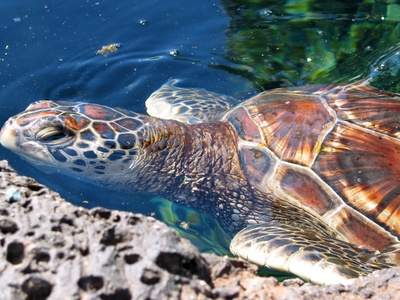
Green Sea Turtle
A classic symbol of the tropical ocean, green sea turtles feed on seagrass and nest on sandy beaches across Micronesia. They face threats from poaching, habitat loss, and plastic pollution.
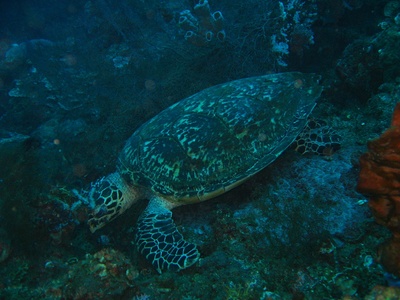
Hawksbill Sea Turtle
This turtle is distinguished by its narrow, pointed beak, used for finding food like sponges in reef crevices. Its beautiful shell has made it a target for illegal trade, pushing it to the brink.
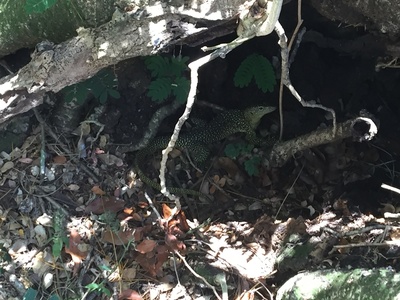
Mariana Monitor
This large lizard, known locally as “hilitai,” is the largest native land reptile in the Marianas. It is an important predator and scavenger, though its populations are impacted by habitat loss and feral animals.
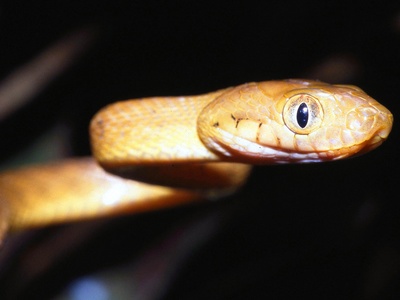
Pacific Tree Boa
A non-venomous, nocturnal snake that lives in trees and forages on the ground for lizards and small mammals. It is one of the few native snake species found in the region.
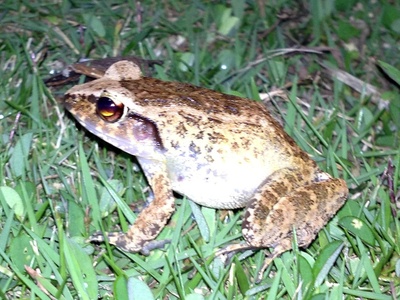
Palau Frog
One of the very few native amphibians in Micronesia, this small frog lives among the leaf litter of Palau’s forests. Its lifecycle is entirely terrestrial, with eggs hatching directly into tiny froglets.
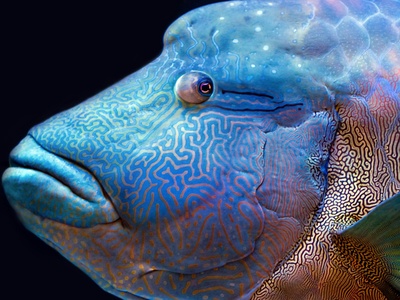
Napoleon Wrasse
This massive, iconic reef fish is known for the prominent hump on its head. It can live for over 30 years but is slow-growing and vulnerable to overfishing, particularly in the live reef fish trade.
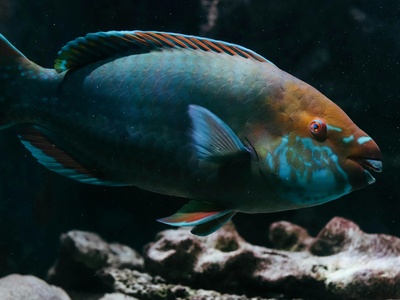
Bumphead Parrotfish
The world’s largest parrotfish, it uses its powerful beak to eat coral and algae, contributing to sand production. They sleep in large groups in lagoons and are threatened by nighttime spearfishing.
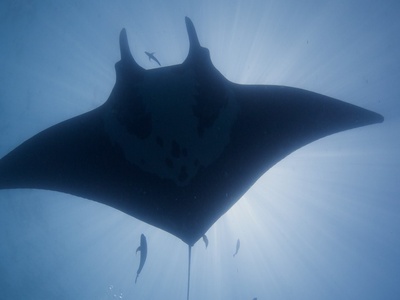
Oceanic Manta Ray
These gentle giants glide through Micronesia’s waters, feeding on plankton. Yap is world-famous for its resident population of manta rays, which are a major ecotourism draw and culturally significant.
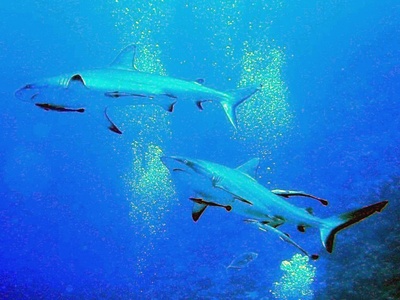
Grey Reef Shark
A common but vital apex predator on Micronesian reefs, known for its curious yet sometimes aggressive behavior. Healthy populations, like those in Palau’s shark sanctuary, indicate a thriving marine ecosystem.
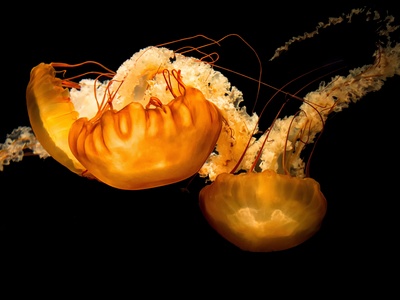
Golden Jellyfish
This unique, non-stinging jellyfish subspecies is found by the millions in Palau’s famous Jellyfish Lake. They follow the sun across the lake daily to cultivate symbiotic algae within their tissues for food.
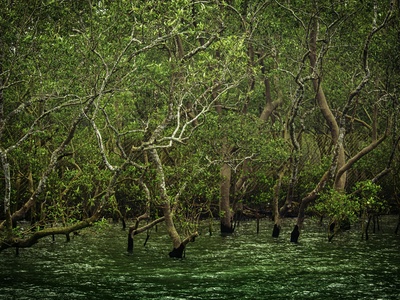
Pohnpei Mangrove Goby
A small, colorful goby endemic to Pohnpei’s clean, fast-flowing streams. The males display brilliant blue and orange colors. They are an indicator of healthy, unpolluted freshwater ecosystems on the island.
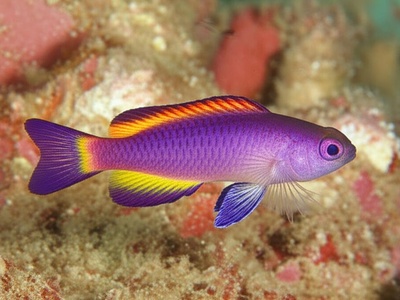
Palauan Dottyback
A small, vibrant fish with a purple body and yellow tail, found only in the waters of Palau. It is a prized species in the aquarium trade but remains common in its natural habitat.
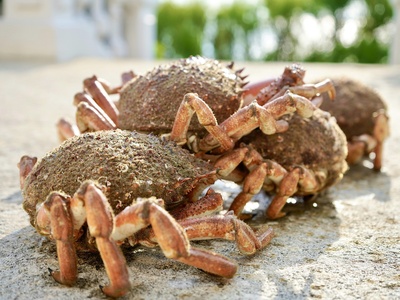
Coconut Crab
The world’s largest land-living arthropod, this massive hermit crab can climb trees to snip coconuts. It is a highly valued food source and is threatened by over-harvesting and habitat destruction.
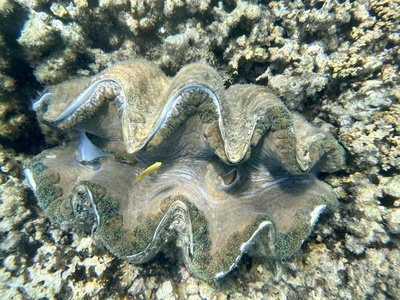
Giant Clam
The largest bivalve mollusk on Earth, capable of reaching over 1.2 meters in length. These filter-feeders are vital to reef health but have been over-harvested across much of their range.
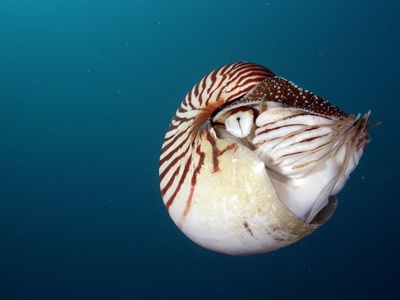
Palau Nautilus
A “living fossil” endemic to the deep waters around Palau. This shelled cephalopod has remained largely unchanged for millions of years and migrates vertically at night to feed in shallower water.
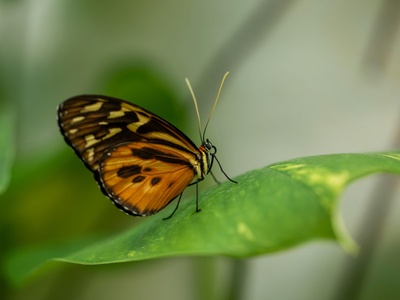
Mariana Eight-spot Butterfly
This beautiful butterfly subspecies is found only in the southern Mariana Islands. It is listed as endangered by the US Fish and Wildlife Service due to threats from habitat loss and introduced predators.
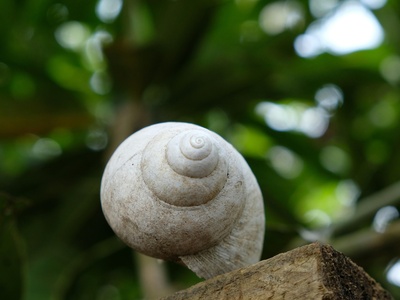
Pohnpei Tree Snail
One of several highly endangered tree snails endemic to Pohnpei. These small, beautiful snails are threatened by introduced predatory snails and habitat loss, representing Micronesia’s silent extinction crisis.
